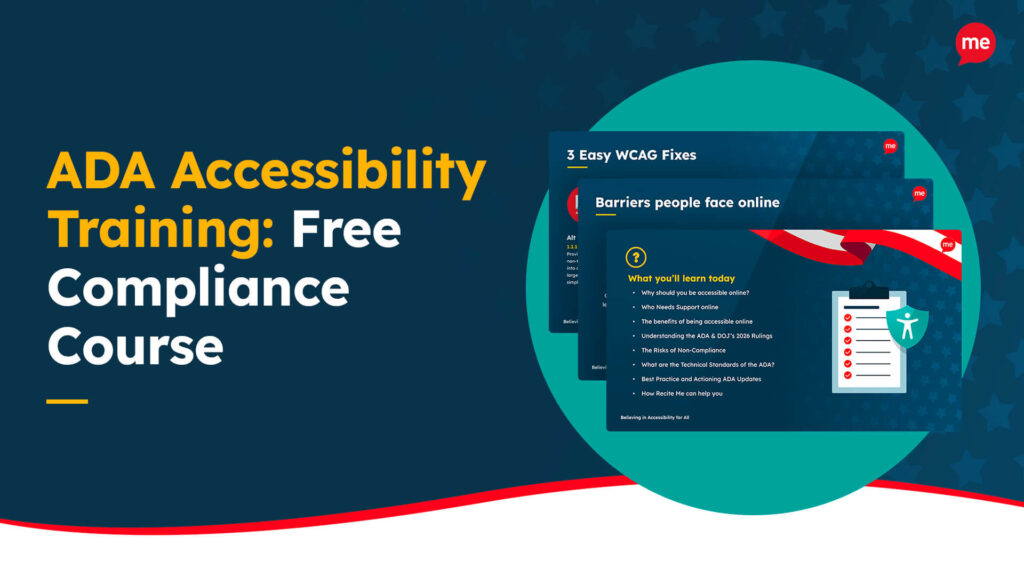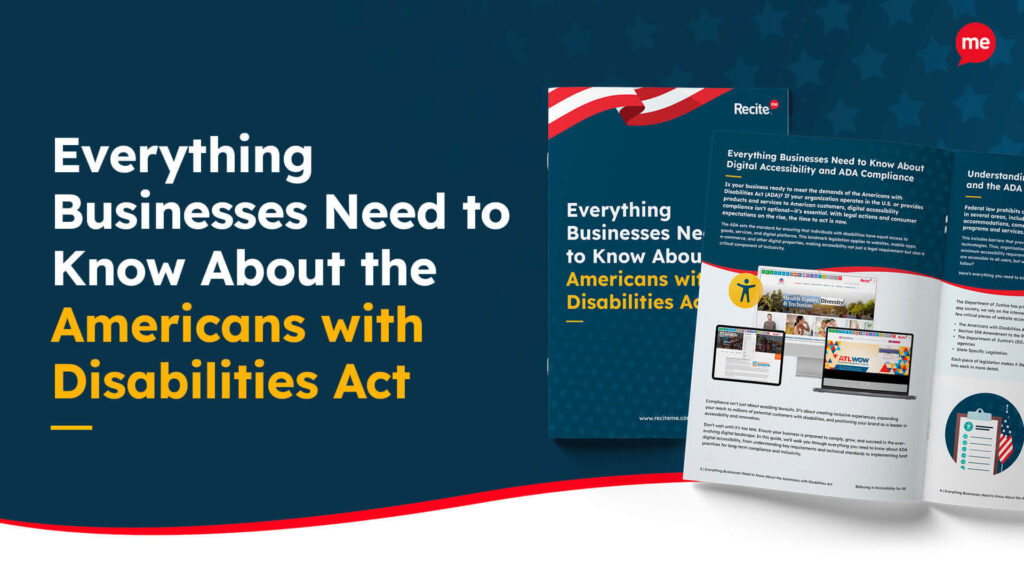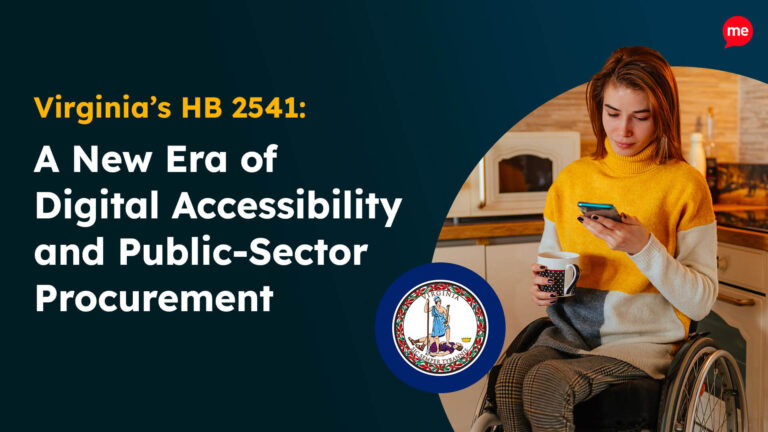Get A Free ADA Compliance Audit Of Your Website
Download NowUnder the Americans with Disabilities Act (ADA), employers are required to provide reasonable accommodations to help individuals perform their jobs. But what exactly does that process involve? Whether you’re an HR professional, manager, or small business owner, understanding how to recognize, evaluate, and respond to accommodation requests is essential. In this article, you’ll learn what ADA accommodation requests are, why they matter, and how you can handle them correctly and compassionately.
What is an ADA accommodation request?
An ADA accommodation request happens when an employee asks you for a change at work to help them perform their job better because of a medical condition or disability. However, the person making the request doesn’t need to mention the Americans with Disabilities Act or even use the term “reasonable accommodation.” They just need to let you know that they need an adjustment at work due to a health-related issue.
These requests don’t have to be formal or in writing. Employees can make them in person, over the phone or by email, i.e. any way they feel comfortable. While you might choose to document the request or ask the employee to complete a form, employees aren’t required to make the request in writing. But it can be helpful for both of you if the employee does put the request in writing, creating a paper trail in case any questions or disagreements come up later.

Here are a few examples of the types of requests you could receive:
- Example A: An employee says to you, “Due to my anxiety, I’d like to work from a quieter space if possible.” This is a request for reasonable accommodation because it links the need to a mental health condition.
- Example B: A team member emails you, “I have a vision impairment and need a screen reader to complete my work tasks.” This is a clear accommodation request tied to a disability.
- Example C (not an ADA request): An employee says, “I’d prefer to work from home because it’s more convenient for me.” While this is a request for a workplace change, it’s not considered an ADA request unless it’s connected to a medical condition or disability.
Which employers are obliged to address ADA accommodation requests?
Under the ADA requirements, if you have 15 or more employees, you’re legally required to consider and provide reasonable accommodations for individuals with disabilities. That is, unless doing so would create an undue hardship for your business.
A reasonable accommodation is any adjustment to the workplace or the way a job is performed that allows a qualified individual with a disability to apply for a role, carry out essential job functions, or access the same benefits and opportunities as other employees.
These accommodations generally fall into three categories:
- Adjustments to the job application process (e.g. offering alternative formats or locations for interviews)
- Changes to the work environment or job duties (e.g. modifying a workstation or providing assistive equipment)
- Access to employee benefits and programs (e.g. making training sessions accessible or modifying break schedules)
To qualify, the individual must have a disability that you know about and must be otherwise able to perform the essential functions of the job, with or without the accommodation.

What Is “Undue Hardship”?
You’re not required to provide an accommodation that would cause undue hardship. This means it would be significantly difficult to accommodate the request, whether because of costs or disruption to business. It depends on factors like:
- The cost of the accommodation
- The size and financial resources of your company
- The structure and operations of your business
Undue hardship is determined case by case. Generally, larger employers with more resources are expected to absorb higher costs or make more complex changes than smaller businesses.
If a requested accommodation is too difficult or expensive, you should explore alternative solutions that might still meet the employee’s needs. In some cases, if cost is the only barrier, you can offer the employee the option to pay for part of the accommodation themselves or provide it independently.
Want to make sure your website is compliant with the Americans with Disabilities Act? Then unlock the ADA compliance checklist now. Discover actionable steps to ensure ADA compliance, helping you avoid lawsuits and any other negative consequences of non-compliance.
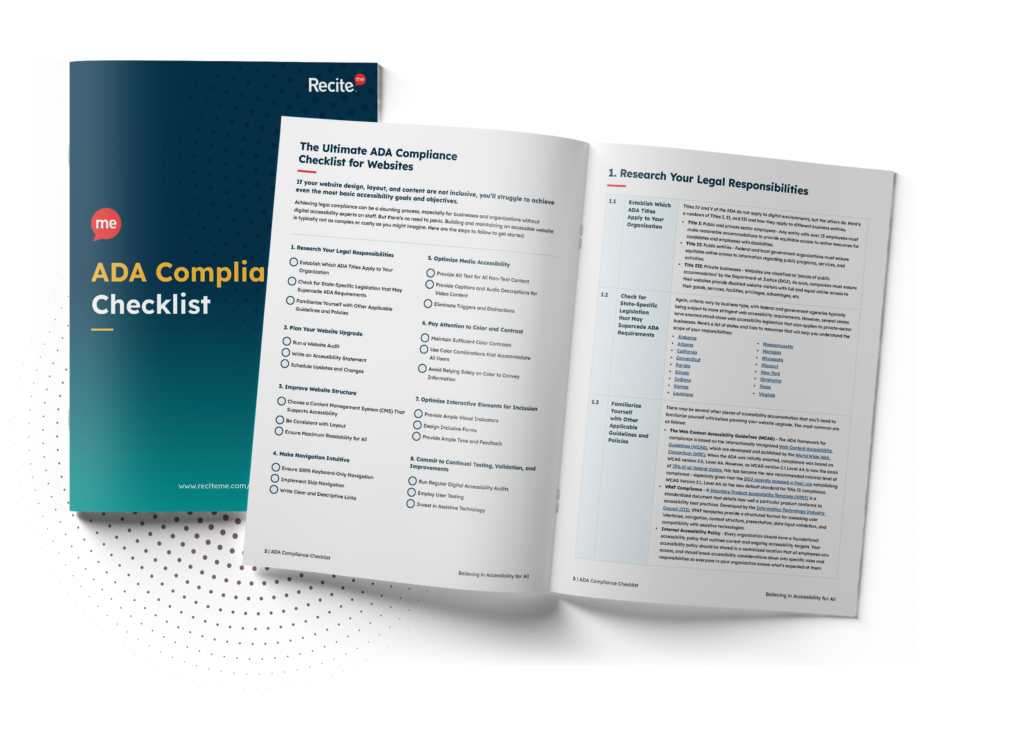
Common types of Accommodations under the Americans with Disabilities Act
Accommodations are sometimes called “productivity enhancers.” You shouldn’t view reasonable accommodations as “special treatment” because they often benefit all employees. For example, providing ramps, accessible restrooms, and ergonomic workstations help more than just employees with disabilities.
Here are some examples of reasonable accommodations you might provide:

Physical workspace adjustments
Physical accommodations help employees with mobility or physical impairments access and navigate your workspace safely and comfortably. Common examples include:
- Installing ramps or wheelchair-accessible entrances.
- Widening doorways to ensure that employees using wheelchairs, scooters, or service animals can move freely throughout the space.
- Modifying restrooms with grab bars, accessible stalls and lower sinks.
- Rearranging desks or equipment to create open space and uncluttered work zones.
- Lowering countertops or shelves to ensure that essential tools and resources are within reach for all employees.
- Installing automatic door openers or touchless systems. These are helpful not only for those with limited strength or dexterity but also for anyone carrying items or pushing a cart.
Assistive technologies
Assistive technologies are tools or systems that enable employees with various disabilities to perform their job duties effectively. By removing technological or communication barriers, they support greater independence, reduce frustration, and foster equal participation. Common examples include:
- Screen readers software converts on-screen text into speech or Braille, making digital content accessible to employees who are blind or have severe visual impairments.
- Speech-to-text software to help employees with mobility or neurological impairments dictate their work instead of typing.
- Screen magnifiers or high-contrast settings.
- Hearing aids compatible with phones or videophones for those who are deaf or hard of hearing.
- Alternative input devices like ergonomic keyboards or mouth-controlled devices.
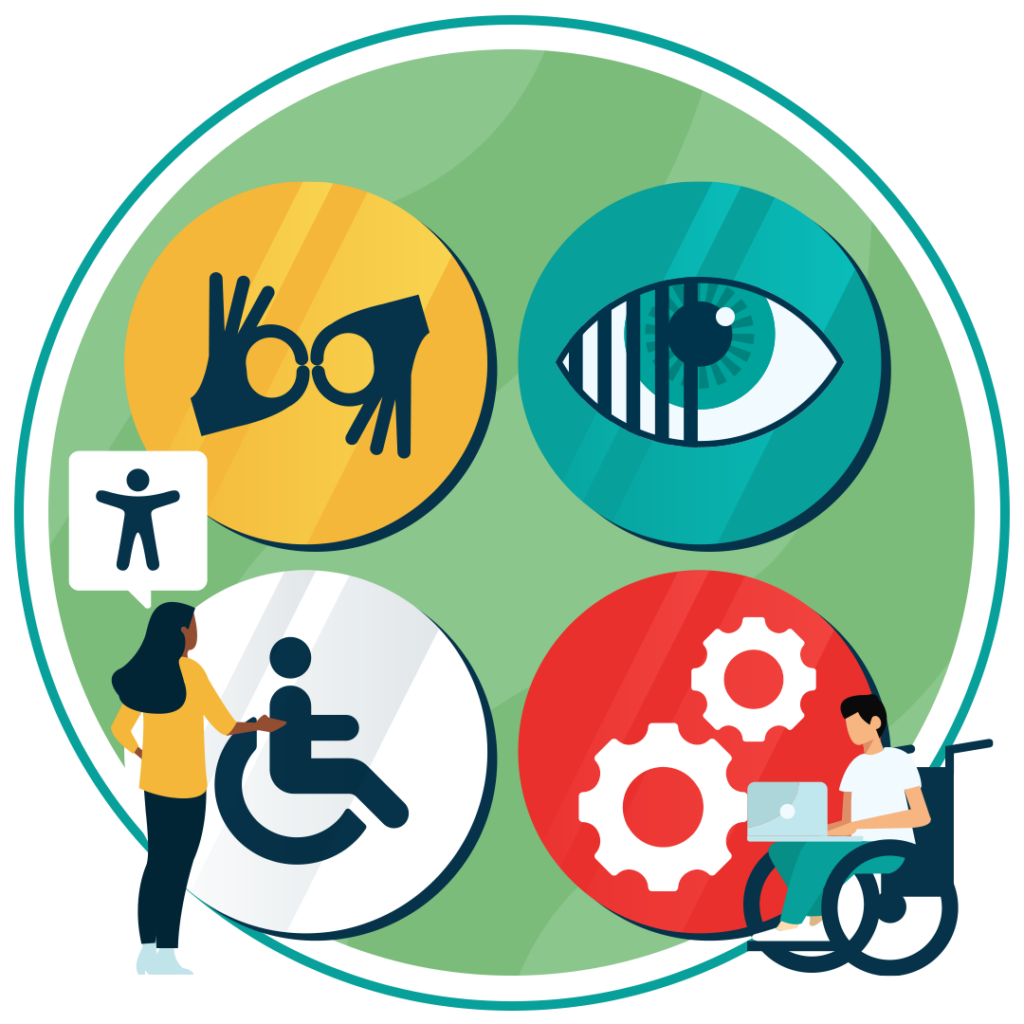

Inaccessible online workspaces
As hybrid and remote work become standard, digital accessibility is just as critical as physical access. Online systems must be designed to accommodate users of all abilities. You can do this by:
- Providing closed captioning or real-time transcription for video meetings and training.
- Offering sign language interpreters during virtual events.
- Making online documents like PDFs screen-reader friendly.
- Ensuring websites and software meet accessibility standards like WCAG.
- Using accessible learning platforms with keyboard navigation and screen reader compatibility.
- Allowing extra time or alternative formats for time-sensitive online tasks.
Handling accommodation requests
Once an employee makes an accommodation request, you need to take it seriously and start an interactive process to figure out what’s needed and possible. Here are the steps you can take to handle a request:
1. Determine reasonableness
Don’t assume every request means you must provide the exact accommodation. Firstly, if your employee’s disability or need isn’t obvious, you can ask for medical documentation to confirm the disability and understand how it affects the job.
Then once you understand the person’s needs, you can evaluate if the request is reasonable and necessary. Ask clarifying questions about the accommodation and how it helps the employee perform their work. Your goal is to identify barriers and find solutions that don’t create undue hardship.
2. Notify the employee of the decision
After reviewing the request, tell the employee your decision clearly. If you approve it, confirm it in writing and explain the next steps. If you deny it, explain why. This could be because either the request is not reasonable, the employee doesn’t meet ADA disability criteria, or it would cause undue hardship. Being transparent will help maintain trust, even if you can’t grant the request as asked.

3. If approved, provide the accommodation with a timeline
Some fixes are quick and others take longer, so give the employee an estimated timeline for completion and keep them updated on delays. Try to offer temporary solutions where possible. Remember, you don’t have to provide the exact accommodation requested, but you must offer an effective solution that removes workplace barriers.
Run regular ADA compliance audits to minimize accommodation requests
By running regular ADA compliance audits on your website, you can proactively identify and fix accessibility barriers before users need to request accommodations. These audits evaluate elements like navigation, color contrast, keyboard functionality, screen reader compatibility, and overall adherence to Web Content Accessibility Guidelines (WCAG).
When your website is designed with accessibility in mind from the start, fewer individuals need to request special access or report issues. The site will already work for a wider range of users, including those with visual, auditory, motor, or cognitive disabilities.
This proactive approach helps you stay ahead of legal requirements, reduces the time spent responding to individual accessibility complaints, and reinforces your commitment to an inclusive digital experience. Regular testing allows you to shift from reactive problem-solving to intentional, user-friendly design that supports all visitors.
Get a free automated ADA compliance audit of your website. This audit will highlight compliance violations and provide the recommendations needed to meet ADA compliance standards.
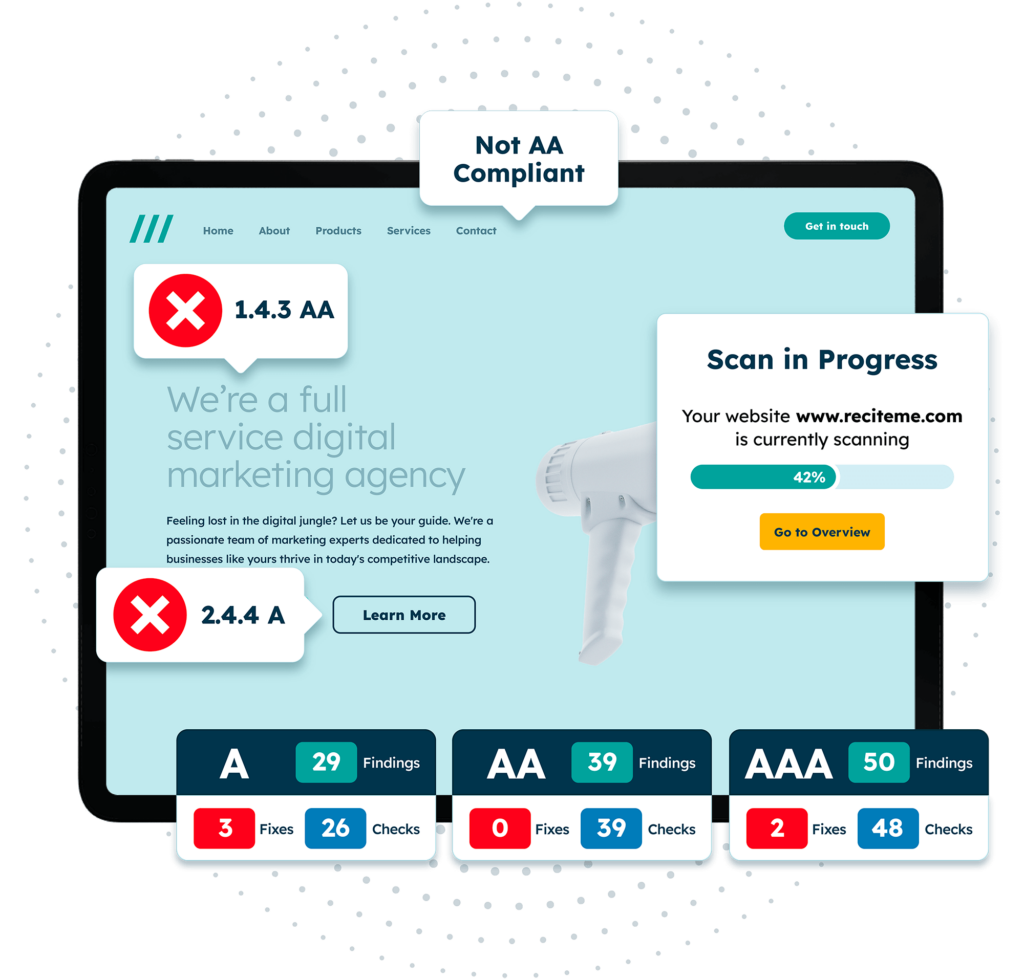
Why is it important to take employee requests seriously?
Taking accommodation requests seriously shows your employees that you value their concerns and needs. When someone reaches out with a request, it often comes from a place of vulnerability. By responding promptly and respectfully, you build trust and a positive workplace culture. Ignoring or dismissing requests can lead to disengagement, higher turnover, and damage to your organization’s reputation.

Legal and financial risks
If your business has 15 or more employees, you’re legally required to provide reasonable ADA accommodations to qualified individuals with disabilities. Ignoring or mishandling these requests can expose you to serious legal risks, including ADA lawsuits.
For example, an employee who’s denied a needed accommodation may file a lawsuit against your company. If the court finds you in violation, you could be ordered to pay monetary damages, including compensation, punitive damages, back pay, or even reinstate the employee. You might also be required to revise your workplace policies, and you’ll likely have to cover the employee’s legal fees.
Protecting employee well-being and productivity
Reasonable accommodations are essential for helping your employees perform at their best. Accommodations like flexible schedules, assistive technology, or ergonomic workstations remove barriers to productivity. When employees feel supported, they’re more engaged and likely to contribute positively. On the other hand, neglecting accommodation needs can lead to increased stress, absenteeism, and health issues, all of which can negatively impact team morale and overall company performance.
Fostering an inclusive culture
By addressing accommodation requests, you’re actively building an inclusive workplace where diversity is genuinely embraced. Plus when you respond thoughtfully to accommodation requests, you demonstrate a real commitment to equity and belonging. This not only boosts employee satisfaction but also enhances your reputation as a compassionate and forward-thinking employer, helping you attract a diverse talent pool.

Conclusion: Make sure you handle ADA accommodation requests correctly
Handling ADA accommodation requests isn’t just a legal requirement, it’s a crucial part of creating a workplace that values equity, dignity, and opportunity for everyone. By taking requests seriously, evaluating them carefully, and working with your employees, you reduce legal risks and strengthen your workplace culture. Armed with this knowledge, you can create an environment where everyone can succeed.
Need more help becoming ADA compliant?
The following resources are packed full of actionable tips and expert advice for making your digital content compliant with the Americans with Disabilities Act:
Free ADA Accessibility Training
Take the first step to ADA compliance by completing our training course.
Free ADA Accessibility Guide
Ensure your organization is meeting the requirements for ADA compliance.

